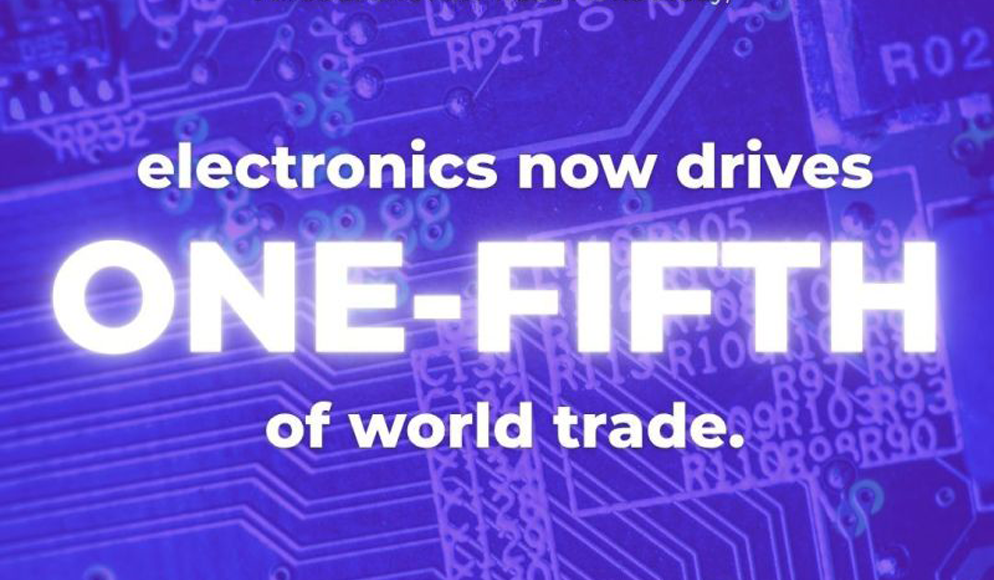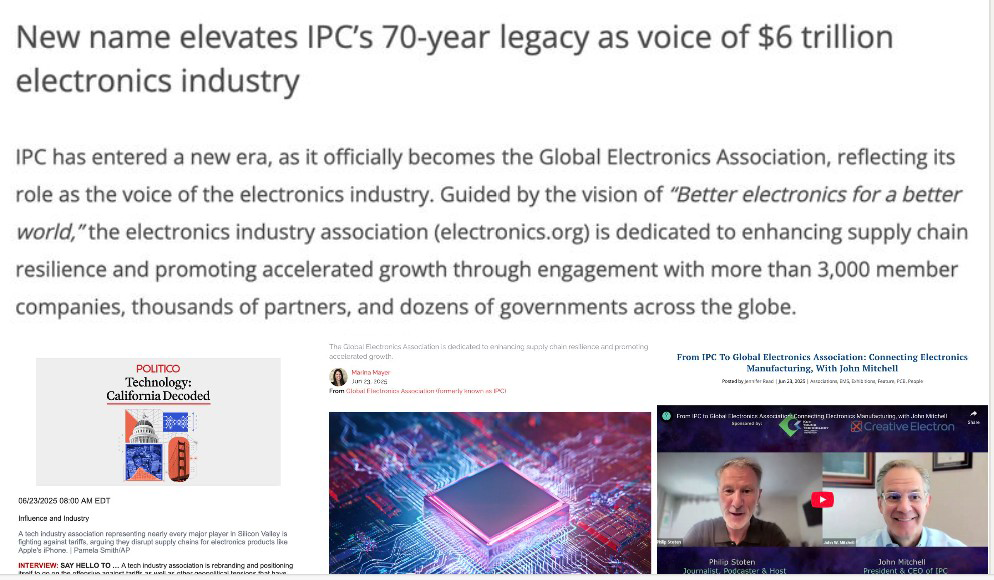 |
Dear [Colleague]:
We're sending this week’s Global Advocacy Report a day early due to the U.S. Fourth of July holiday, but there’s no shortage of policy developments to keep your eye on.
In Washington, the Senate’s passage of President Trump’s sweeping “One Big Beautiful Bill Act” sets the stage for a final vote today by the House, with major implications for tax policy, trade, and electronics investment.
Across the globe, Mexico continues to draw advanced manufacturing investment while navigating shifts in auto production and compliance demands. In Southeast Asia, Vietnam is stepping up its role with new workforce training partnerships and domestic chip innovation, while Malaysia deepens ties with China in semiconductors and smart manufacturing.
And in case you missed it: the Global Electronics Association just launched a new Circularity Resource Hub, our latest effort to equip the industry with tools for sustainable design and regulatory readiness.
Scroll down for your five-minute update, and as always, reach out with any thoughts or feedback.
Chris Mitchell
Vice President, Global Government Relations
The Headlines at a Glance:
QUOTE OF THE WEEK
- Global Electronics Association President and CEO John W. Mitchell Covers Organization's New Brand
TOP NEWS OF THE WEEK
- Big Beautiful Bill Clears Senate, Nears Final Passage in House
GLOBAL
- Global Electronics Association Debuts with New Vision, Mission
- Electronics is Most Globally Integrated Industry, New Study Shows
UNITED STATES
- White House Seeks Input for National Strategy for Advanced Manufacturing
MEXICO
- Electronics Manufacturing Expands in Mexico Amid Nearshoring Trends
ASIA
- Trump Announces U.S.-Vietnam Trade Deal
- Vietnam Advances in Electronics with Workforce, Innovation, and Trade Focus
- Malaysia and China Deepen Trade Cooperation in Strategic Sectors
EUROPE
- EU Launches Strategy to Lead in Quantum Technologies
ENVIRONMENT AND SUSTAINABILITY
- Global Electronics Association Launches Circularity Hub for Sustainable Design
UPROMING EVENTS
- Global Electronics Midyear Economic Check-In, Online, July 8
OTHER HEADLINES IN THE NEWS
- U.S. News | EU Wants Upfront Relief for Key Sectors in Any US Trade Deal
- The Nation | Thailand Enforces Sweeping Ban on Electronic Waste Imports
HELP US SPREAD THE WORD ON SOCIAL MEDIA
KEEP IN TOUCH WITH US
 |
 |
— John W. Mitchell, Global Electronics Association president and CEO, in a LinkedIn post on the launch of the organization’s new brand
 |
Big Beautiful Bill Clears Senate, Nears Final Passage in House: U.S. President Donald Trump and congressional Republicans appear to be on the verge of completing their sweep of the legislative process, as the House of Representatives overnight cleared a procedural vote on the “One Big Beautiful Bill Act,” the package of tax cuts and spending and policy changes designed to implement the president’s agenda. A final vote in the House is expected within hours.
The headlines for IPC will be in the tax title of the bill, and while we’re still waiting to see the final language, the Senate version of the bill favorably addressed many of our concerns. According to CNN, the bill extends and adds a variety of tax cuts and incentives aimed at reshoring manufacturing, with numerous provisions that could help the electronics industry. As reported by Bloomberg, the bill’s semiconductor and electronics sections include new deductions for domestic R&D spending, accelerated depreciation for capital equipment, and tariff exclusions for components not available from U.S. sources. These measures could help ease supply chain constraints and encourage investment.
The Global Electronics Association will provide fuller details as soon as possible. In the meantime, with other important business coming next – the defense authorization bill, new trade agreements, and FY26 spending bills – electronics manufacturers should stand by to engage in more advocacy work with us. Contact: Richard Cappetto
 |
Global Electronics Assn. Debuts with New Vision, Mission: Last week, the electronics industry opened a new chapter as IPC became the Global Electronics Association (electronics.org), reflecting its role as the voice of the global electronics industry. Guided by the vision of “Better electronics for a better world,” the association is dedicated to enhancing supply chain resilience and promoting accelerated growth through engagement with more than 3,000 member companies, thousands of partners, and dozens of governments across the globe.
As part of its new mission, the Association is increasing resources to strengthen advocacy, deepen industry insights, and enhance stakeholder communications — all aimed at advancing and elevating the electronics industry. POLITICO’s California Decoded newsletter said the association is “positioning itself to go on the offensive against tariffs as well as other geopolitical tensions that have scrambled electronics supply chains.”
Read the full news release and delve into additional resources about the change.
Electronics is Most Globally Integrated Industry, New Study Shows: The Global Electronics Association recently released a study showing that electronics supply chains are more globally integrated than any other industry, surpassing even the automotive sector in cross-border complexity. Trade in inputs like semiconductors and connectors now exceeds trade in finished products such as smartphones and laptops, with global electronics trade totaling $4.5 trillion in 2023, including $2.5 trillion in components alone.
According to Politico Pro Europe, “The group points out that electronics represent 1 out of every 5 dollars in global merchandise trade, and it warns that Europe 'remains heavily and increasingly reliant' on China for both inputs and finished electronics.” The interdependence of global electronics production challenges the viability of reshoring and decoupling strategies, the report says. Contact: Shawn DuBravac
 |
White House Seeks Input for National Strategy for Advanced Manufacturing: The White House Office of Science and Technology Policy (OSTP) is gathering input from all interested parties on the development of a National Strategic Plan for Advanced Manufacturing. The Request for Information (RFI) is seeking insights on federal policies and programs to advance U.S. manufacturing competitiveness, including advanced manufacturing R&D “that will create jobs, grow the economy across multiple industrial sectors, strengthen national security, and improve healthcare.” Responses are due by September 30, and our association will prepare comments. Your input is welcomed. Contact: Richard Cappetto
 |
Electronics Manufacturing Expand in Mexico Amid Nearshoring Trends: Mexico continues to attract investment in electronics and advanced manufacturing, although recent developments show a dynamic and evolving landscape. The state of Guanajuato secured over $2.2 billion in new investments across 22 projects in just five months, primarily in automotive and industrial manufacturing, with key backing from Japan, the U.S., Germany, and China, according to Mexico Industry. Benchmark Electronics also opened a new 10,000-square-meter design and manufacturing center in Jalisco, focused on aerospace, medical, and semiconductors, as reported by Global Data. Mexico Now reports that General Motors will shift production of two SUV models from Mexico to Michigan by 2027, although the company’s Mexican operations in electric vehicle components remain strong.
Meanwhile, Mexico’s aerospace industry is targeting $19.6 billion in annual value by 2029, supported by FDI and new supplier growth, according to Mexico Now. This push will likely bring new quality and compliance requirements that electronics manufacturers should watch closely. Leadership is also shifting: four Mexican women now hold top regional roles at Ford, Nissan, and Stellantis, shaping production and innovation across North America, as highlighted by Puerto Interior Guanajuato. These developments underscore why Mexico remains a key piece of the North American supply chain, and why GEA members should stay engaged. Contact: Lorena Villanueva
 |
Trump Announces U.S.-Vietnam Trade Deal: U.S. President Donald Trump said Wednesday that the United States has struck a trade deal with Vietnam that includes a 20% tariff on the southeast Asian country’s imports to the United States. The United States will gain mostly tariff-free access to Vietnam’s markets. Vietnam also agreed that goods would be hit with a 40% tariff rate if they originated in another country and were transferred to Vietnam for final shipment to the United States – a tactic that China is accused of using to circumvent trade barriers. Our association will provide more details as we learn them. Contacts: USA, Richard Cappetto; Asia, Gaurab Majumdar
Vietnam Advances in Electronics with Workforce, Innovation, and Trade Focus: Vietnam is taking new steps to strengthen its role in the global electronics supply chain, with developments in workforce training, domestic innovation, and regional trade policy.
According to Vietnam Economic Times, Foxconn is partnering with Vietnamese authorities to help train a next-generation technology workforce. The company plans to support education in semiconductor-related skills, aligning with national goals to produce 50,000 semiconductor engineers by 2030. In parallel, the first analog-to-digital converter (ADC) chip designed and manufactured in Vietnam was recently introduced by the State-owned Viettel Group, Vietnam Economic Times reports. While not yet produced at commercial scale, the breakthrough represents early steps in building core electronics capabilities in-country.
Vietnam is also navigating trade complexities within the ASEAN region. Non-tariff barriers, including technical standards, customs delays, and regulatory divergence, continue to impact cross-border electronics trade. Vietnam Economic Times notes that industry stakeholders and policymakers are calling for greater transparency and harmonization to improve intra-ASEAN trade flows. These shifts in Vietnam’s industrial strategy and regional engagement could affect supply chains and sourcing decisions for electronics manufacturers worldwide. Contact: Gaurab Majumdar
Malaysia and China Deepen Trade Cooperation in Strategic Sectors: Malaysia and China are entering what officials have called a “new era of cooperation,” with strengthened bilateral ties focused on technology, infrastructure, and industrial investment. According to Business Today Malaysia, recent meetings between senior government and industry leaders from both countries emphasized alignment in high-value sectors including semiconductors, smart manufacturing, and green technologies. The talks included commitments to expand collaboration on supply chains and innovation ecosystems.
This deepening relationship comes as Malaysia positions itself as a regional electronics hub and seeks to attract more Chinese investment into advanced manufacturing. The Institute for Small and Medium Enterprises (INSKEN) noted that these efforts are part of a broader strategy to bolster economic resilience and competitiveness. For electronics manufacturers operating across Asia-Pacific, evolving trade dynamics between Malaysia and China may influence investment patterns, sourcing decisions, and regional standards coordination. Contact: Gaurab Majumdar
 |
EU Launches Strategy to Lead in Quantum Technologies: The European Commission has unveiled a new Strategy aimed at making the EU a global leader in quantum technologies by 2030. According to the Commission, the Strategy focuses on five core areas: research and innovation, infrastructure development, ecosystem support, space and dual-use applications, and workforce skills. A legislative proposal, dubbed the Quantum Act, is expected in 2026 and will aim to boost industrialization by encouraging Member States, companies, and researchers to co-invest in pilot production facilities through coordinated national or regional efforts. These initiatives may create future opportunities and standards with implications for electronics manufacturers across the supply chain. Contact: Alison James
 |
Global Electronics Association Launches Circularity Hub for Sustainable Design: The Global Electronics Association has launched a new Circularity Resource Hub aimed at helping electronics manufacturers implement sustainable design practices at scale. According to eeNews Europe , the Hub offers centralized access to key industry standards, frameworks, and tools to support compliance with evolving global regulations such as Right to Repair and Ecodesign. It also features in-depth guidance on embedding circularity across the product life cycle and reducing e-waste through design for repairability, rework, and materials reclamation.
Global Electronics Association President and CEO John Mitchell said the Hub was created in response to industry demand for practical solutions that balance sustainability with cost efficiency. The resource will be continuously updated to address new challenges, with a focus on supporting risk reduction and long-term resilience. As Dr. Kelly Scanlon, GEA’s Lead Sustainability Strategist, emphasized, “The electronics ecosystem has an opportunity to embrace circularity to reduce risk – and minimize its life cycle impacts in the process.” Contact: Kelly Scanlon
 |
Global Electronics Midyear Economic Check-In, Online, July 8: We’re at the midpoint of 2025, and the global economy is walking a tightrope between resilience and risk. What does this mean for the electronics industry? Join us for a live webinar next week with Global Electronics Assn. Chief Economist Shawn DuBravac, Ph.D., CFA, who will offer a data-driven, industry-relevant look at what lies ahead, from supply chain disruptions to geopolitical flashpoints. Learn more and register here.
 |
 |
 |
KEEP IN TOUCH WITH US Meet Our Government Relations Team: Whether it is engaging with policymakers in the Americas, Europe, or Asia, the Global Electronics Association Government Relations (GR) Team works to educate, inform, and influence policymakers on policies that affect our industry. Our success depends on active support and participation from attentive people like you!
Peruse our global Advocacy pages on electronics.org and follow the links to information about our work in North America, Europe, and Asia. Subscribe to the Global Advocacy Report: If you are a member of the Global Electronics Association, manage your e-mail preferences and opt in to receive all “Advocacy” updates. If you are not a member — or if you are not sure — please send a note to friends@electronics.org, and our staff will add you to the list. See prior editions of Global Advocacy Report. Please contact one of us via the links above if you have any questions or insights to share! |

